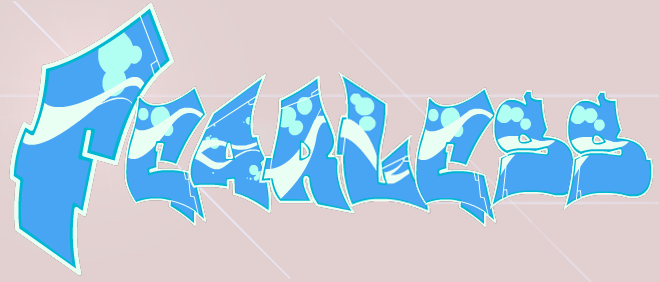(Or, visualisation, if it please you, Beth. ;))
I think writers should be as visual as traditional artists. Perhaps more so, because we need to provide description for a reader, without the benefit of a comic panel or moving image. But, dwelling on description overlong can become tedious for a reader, and that we never want.
“Good morning,” he replied, coming to a slow stop in front of her. He propped his board beside him, shielding her from the bright sun; it didn’t make her any less pretty.
“Ah…Amber, yeah?” he said, feigning blase non-involvement.
She nodded. “And you’re…” She paused a moment. “Fearless?”
He snorted. “Close enough. Ross.”
“Right,” she said. Though from her smile, he guessed she hadn’t needed the reminder, either.
He raised his brow at her. “You need help with something?”
“You said I should stop by,” she reminded him, as she glanced up at the sign of the shop, with its graffiti-style lettering. Looking back to him, she smiled again. “So, here I am.”
“Here you are,” he echoed, as he felt himself break into a smile, too.
That’s the only time the shop sign is mentioned, but I still came up with a design:
Mostly, I did it because I like playing around with graffiti. But, I also think it’s important for a writer to have a firm vision of the world in which their characters live. The more we know – either in our heads or on the page – the less we need to explain to the reader: the details usually invariably find their way into the story on their own.
I design (or, at least, I keep detailed notes for) every location of any import in my stories, from Ross’s living loft above the shop, to Amber’s hospital room, to the Truro flat. I did the same for a Japanese apaato and a country ryokan, a starfaring tramp tanker and a soldier’s little love nest. Because understanding where your characters are will help everyone understand where they go, how, and why (we call that “blocking” in theatre-speak).
How do you design your locations in your stories?


For me I think my locations tend to be places that I am very familiar with, but that I have changed change a bit. So I might picture the house I grew up in, but it’s in a different street, and the colour scheme is different. I find the combination of familiarity with something fresh and new works best for me.
* Just one changed, not changed change!
I’m very much a fan of the familiar, too, Vanessa. One character’s apartment was a tweaked version of my first apartment, while another character’s family home was based on my grandparent’s house. (All hospital rooms feel the same to me, these days.)
I think the important part is knowing your locations to be able to describe them in enough detail to make them feel real, while not taxing a reader’s patience threshold. 😀
Thanks for commenting!
Many scenes in my WIPs take place in surroundings I’m familiar with: DC, Maryland, and Virginia. And like Vanessa, specific places like a character’s home are loosely based on houses I know. But when I a have a completely foreign location (such as another planet), I try to engage all my senses to understand it—not just the sights, but also the sounds and smells, for example.
Totally agree about the other senses, JM! That’s a good point for a future post: engaging more than just a reader’s sight. Of course, sight tends to be primary for the reader, since it’s the easiest way to convey a location.
I’ve actually got a blind character from this year’s NaNo, that I’ve been considering writing a bit from her perspective, just to take away the sense of sight. Should be fun!
Thanks for stopping by!
I like to draw maps of the town or the neighborhood or even a house’s floorplan. Like you, I agree that having a firm idea of setting is important. It also helps to remember where certain sites are located in relation to other sites, such as knowing that the abandoned railroad track runs behind the military housing or that the saltwater marsh is to the right of the road. Tiny directional details which are easy to lose in a whole novel.
Incorporating all the senses as a part of establishing setting, like JM mentions, is something I try to do also.
I like the sign you made. That’s pretty much how I envisioned it when you described it in your excerpt, so to see it in ‘real life’ was neat.
Thanks, Kate.
I agree with you that topical geography (not just house layouts and such) is important to creating believability in a story, too. It’s almost more important in a newly-imagined world, because the world should make sense for the reader. (Though, I have read stories where the geography is an ever-changing mishmash, but that has more to do with the adventure than an author not paying attention.)
I’ve got to try harder to incorporate more senses into my descriptions. I always have to remind myself to put in smells or textures…but sights are just so easy! 😀
Thanks again for commenting. 🙂
Nice logo.
As for how I design, I take parts of places that I’ve seen and mash it together, mostly. From there, I tweak some areas that need the tweaking. I’m currently trying to figure out how to make a two-floor small office work on the side of a house, whether I should have a fireman pole for kicks or a narrow spiral staircase. I’m enjoying the whimsical part of designing it in my head, but I may have to draw out floor plans for the entire house.
I end up focusing more in more enclosed areas, like houses. Everything else, like nature or shopping areas, end up with “generic” trees or “rows of buildings,” so I end up getting bored easily.
I’m a fan of the mash-up technique, too. As for the “generic trees” and “rows of buildings,” there’s not usually reason to go into scores of detail in those situations. I occasionally indulge for sake of immersion, but usually those have to come out in editing. 🙂
Thanks for commenting, spooney!
Thank you for your post, Mayumi. It’s very informative. And Mayumi, I know it is the 13th of January, but I hope it is not too late to wish you a wonderful New Year. May 2013 bring you more happiness, love, and success, especially with your publication endeavors. 🙂 I would like to thank you because you continue following my blog. I hope my blog posts do not disappoint and that your visits in there have been a joyful ride. Thank you again, many blessings and much love to you. 🙂
Subhan Zein
Of course, it’s not too late! Thank you, and happy new year to you, as well! I hope 2013 graces you with greater happiness and peace. 😀
thank you, Mayumi, many blessings and much love to you.. 🙂
Subhan Zein
I love your thoroughness – having that design of the shop sign! I think you hit on something in your opening, which is to have enough to create the image for the reader, but not too much to slow the story down. A lot of my students put in description because they want to show off their writing skills and that’s when things start to go wrong…(Came here through Vanessa’s blog and a comment you left, in case you’re wondering where I sprung from!)
That’s my problem with description, too – pure pride. 😀 It’s a tricky balance to maintain, though. I want to create a lush world, but I don’t want to get so steeped in the building that the reader doesn’t notice (or care) when I start to tear things down.
Thanks for stopping in!